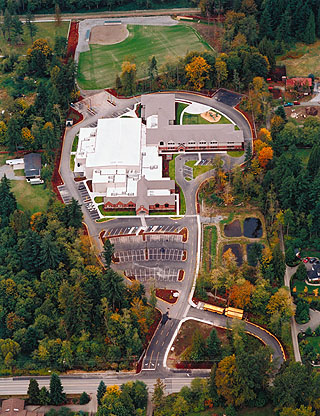|
Subscribe / Renew |
|
|
Contact Us |
|
| ► Subscribe to our Free Weekly Newsletter | |
| home | Welcome, sign in or click here to subscribe. | login |
Construction
| |
 |
August 31, 2006
Getting around permitting hurdles takes creativity, teamwork
BCRA

Bills
|

Mellot
|
We all know it requires great perseverance and commitment to navigate the entitlement hurdles in today’s complex permitting system. Occasionally unorthodox means are needed in order to ensure that a client’s ultimate needs are met.
School projects are often driven by two factors — budget and schedule. Bonds have been passed and the first day of class has been scheduled. However, when unknown land-use issues are discovered, a wild card is suddenly thrown into the deck, and the design team’s sink-or-swim test begins.
When land-use issues arise, they are almost always time-consuming and outside the control of the owner or the design team. This lack of control can often adversely affect the final completion, and thus the opening day, of the facility.
When school administrators and facility managers are working within their own structures to find temporary locations for students during remodels or the demolition of a facility in use, a delayed schedule can create significant headaches for schools scrambling to reassign staff, faculty and students to new locations.
Needless to say, this all impacts the overall project budget. Such impacts include extended rent, increased temporary housing costs, increased escalation costs for construction of the new facility, and additional contractor costs for the extended schedule, to name a few.

Photo by BCRA A Redmond school faced unexpected water requirements when it sought to file a campus master plan before new land-use rules took effect. The design team raced to assemble a new water plan before the deadline. |
Some of the typical land-use issues that cause these types of delays include water rights, conditional use permits, neighborhood disputes, septic systems, and traffic and noise studies and mitigation.
An entitlement conundrum
With a constant array of changing regulations, layers of regulations sometimes create a Catch-22 situation for the client.
We recently experienced this with a private school client in Redmond where state and county regulations and water district requirements collided, placing our client in an entitlement conundrum. (A pending application prevents us from naming the school.)
The main campus had opened four years earlier. The school was extremely successful and significantly increased its enrollment. The need for a new school was inevitable, and the client began the process of fundraising and programming.
The school decided to consolidate all its operations into one campus in the coming years. Its original 14-acre site grew to nearly 35 acres after the school acquired land from its neighbors.
Before expanding, the school was required to file a conditional use permit application for the master plan of the future campus. New King County regulations regarding clearing limits in rural areas would soon eliminate the school’s ability to expand its campus, putting the school and design team under tremendous pressure to resolve a host of complicated issues and submit the permit application before the county’s new deadline.
In addition, the local water district had capacity problems and needed to construct additional water tanks. In the interim, the district imposed a moratorium on new water connections.
Although it was clear to everyone that the new tanks would be constructed in plenty of time for the expanded campus, the permit application still required a certificate of water availability in order to be deemed complete, and thus vest the project under the current land-use rules. The application needed to be submitted immediately to obtain that vesting.
Plan B
After several meetings with the county and the water district, it became clear that there would be no waiver of the requirement for the water availability certificate. So we decided to pursue the development of a separate water system just for the school.
We initiated the process with the state Department of Health and prepared a water system plan with PACE Engineers. The plan was completed just in time to submit the permit application with assurance that the school would have water available for its projects.
Currently, the water district is in the process of completing the construction of its tanks, and once they are complete the district will be able to provide a certificate of water availability for the school projects.
At that point the school will be able to rescind the request to construct the new water system. The school will be able to get its water from the district as originally intended.
This complex approach to navigating agency regulations is only effective if the design team works together to adhere to deadlines. As we have learned, having multiple disciplines under one roof dramatically increases the ability of the team to successfully manage multiple overlapping environmental reviews, analyses and permitting actions.
Use of innovative approaches, early lessons learned and information exchanges was integral to the identification and growth of tailored approaches for the development and review processes.
Above all, every member of the design team — from the land use planners to the civil engineers and architects — was held accountable for creativity and communication. Only a “think out of the box” attitude will get you over what may seem like an impassable mountain of agency regulations.
Terrence Bills is a project manager at BCRA, and Donald Mellott is the director of civil engineering.
Other Stories:
- Schools losing out as construction costs soar
- Flexible classrooms are a perfect fit
- Careful builders can avoid contract disputes
- Does your school building make the grade?
- Gateway opens up a closed-off campus
- State beefing up health and safety requirements
- Rain gardens: effective, natural and cheap
- Partnerships a high note for school, community


